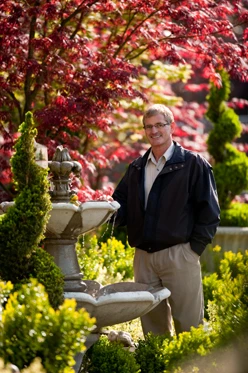
 Photo: Mark Gamba PhotographsAfter a four-year hiatus, David Snodgrass decided it was time to get back into retail. To diversify his company, Snodgrass, president of Dennis’ 7 Dees Landscaping & Garden Centers in Portland, Ore., went back to the foundation his grandparents built more than 80 years ago and bought back a group of garden centers his brother had sold off. And by adding a hybrid DIY design service for homeowners, he’s been able to leverage those storefronts into a lead-generating machine for his landscape division.
Photo: Mark Gamba PhotographsAfter a four-year hiatus, David Snodgrass decided it was time to get back into retail. To diversify his company, Snodgrass, president of Dennis’ 7 Dees Landscaping & Garden Centers in Portland, Ore., went back to the foundation his grandparents built more than 80 years ago and bought back a group of garden centers his brother had sold off. And by adding a hybrid DIY design service for homeowners, he’s been able to leverage those storefronts into a lead-generating machine for his landscape division.
Getting Back in the Game
Snodgrass, who’s president-elect of the Professional Landcare Network (PLANET), and his siblings moved back into garden centers due to their love of plants and their history. Their maternal grandparents started the business in the 1920s—Bernard Esch running a lawn maintenance operation and his wife, Florence, selling rhododendrons in Portland. The family’s second and third generations expanded into retail in the 1950s, with the oldest Snodgrass son, Dennis, naming the new company after himself and his siblings, Daryle-Linn, Drake, Dan, David, Drew and Dean.
“I, and I think my brothers share this, love every aspect of the green industry. One more piece of that industry is a good thing,” Snodgrass said.
And the company’s five garden centers are a boost for business. Besides better discounts for bulk purchases from suppliers and savings on administrative overhead, they act as a great source of leads—and sales—for its landscaping division.
Keeping Customers
Homeowners will order a big installation, and the Dees’ landscaping division can handle it, but those clients aren’t ordering a new project every other month—maybe every few years, if the economy’s good to them, or if they buy a new house.
During the in-between times, Snodgrass’ retail arm can maintain contact with them—flats of annuals for the front beds or tomato plants for their vegetable garden—instead of losing them to another garden center.
“We lost them, I guess, and allowed them to go to competing garden centers, and sometimes those competing garden centers offer landscaping services,” Snodgrass said. “This way, we’re able to service our customers regardless of where they are in their buying cycle. We’re able to keep their attention and keep them as an ongoing customer throughout that process.”
And the sales process works in the opposite direction, too. The landscaping division has a presence at each of the five garden centers, and all the sales associates are trained to guide customers to the right level of project —from DIY to do-it-for-me.
“A lot of times we can turn that customer into either a bigger landscape sale and still have them do the work themselves, or give them a proposal do to the work. It’s been a real good source of leads,” Snodgrass said.
Economic Advantage
And, the garden center purchases helped stabilize the 200-plus employee company’s balance sheet: 24 percent of its $18.5 million in revenue last year came from residential design/build; 28 percent from commercial bid/build; 18 from landscape maintenance and 29 percent from retail.
“It bucks the economy trend,” Snodgrass said of his retail division’s performance this year—up when other areas are stable or down. “That goes back to the diversification—the green industry is never hitting on all cylinders in all areas. Sometimes there are pockets of strength and pockets of weakness. Being diversified allows us to leverage the pockets of strength into the pockets of weakness.”
Snodgrass stresses that, for now, retail is a pocket of strength. At least for this year. Last year, not so much. For example, Snodgrass’ five garden centers pulled in $35,000 total during a recent spring weekend. That same weekend last year, they made $113,000—more than triple this year’s revenue.
“You just have to suck it up, and sometimes you win, sometimes you lose. This year, sales for the garden centers are up 60 percent (overall). We had an early spring, maybe there’s some pent-up demand showing. There’s a huge interest in vegetable gardening. There are just a lot of things that bode well for being in the garden center business this year.”
One of those things is Snodgrass’ Planscaping program. About a year and a half after getting back into the retail arena, Snodgrass introduced the hybrid DIY offering.
Homeowners interested in installing plants themselves, but who want a professional plan to work from, can sit down with one of Snodgrass’ designers and get a professional design, provided they purchase enough plant material from Dennis’ 7 Dees garden centers.
The idea is that the company can think about things like creating outdoor spaces, complementing structures, sight lines and overall curb appeal so homeowners won’t have to.
“We’re trained landscape designers and contractors. That’s our grounding. We have brought that into the retail garden center arena, so we have a level of professional design that’s not going to be part of a garden center that expands into landscaping or a garden center that’s going to offer some type of DIY service,” he said.
“People don’t know what it is—they can walk into a garden center and they say, ‘Man this is really a great place. They don’t pinpoint that the rows are perfectly straight, or that merchandise is stacked from low to high. They don’t understand what went in to giving them that feeling. It all adds up to a wow. It just works. You don’t need to know the details about it.”
The author is editor of Lawn & Landscape. Send him an e-mail at cbowen@gie.net. Read even more about Snodgrass’ operation and get vauable tips online at www.lawnandlandscape.com.

Explore the August 2010 Issue
Check out more from this issue and find your next story to read.
Latest from Garden Center
- NewGen Boxwood added to Proven Winners ColorChoice line
- Terra Nova releases new echinacea variety, 'Fringe Festival'
- Sakata Seed America celebrates renovation of Cal Poly greenhouse complex
- American Horticultural Society names winners of 2025 AHS Book Awards
- American Horticultural Society announces winners of 2025 Great American Gardeners Awards
- Ask HR: We got a bad review after an employee having a bad day snapped at a customer. What do I do?
- How to cultivate connections with vendors
- The Growth Industry Episode 3: Across the Pond with Neville Stein





